Impact of Land Use/Land Cover Change on Landslide Susceptibility in Rangamati Municipality of Rangamati District, Bangladesh
Abstract
:1. Introduction
2. Materials and Methods
2.1. Study Area
2.2. Landslide Susceptibility Mapping
2.2.1. Landslide Inventory and Landslide Causal Factors
Relatively Stable Causal Factors
Land Use/Land Cover
Existing LULC of 2018
Proposed Land Use/Land Cover
Simulated Land Use/Land Cover
2.2.2. Random Forest Model and Accuracy Assessment
3. Results
3.1. LULC Scenarios
3.2. Landslide Susceptibility Mapping
4. Discussion
5. Conclusions
Author Contributions
Funding
Institutional Review Board Statement
Informed Consent Statement
Data Availability Statement
Conflicts of Interest
References
- Reichenbach, P.; Rossi, M.; Malamud, B.D.; Mihir, M.; Guzzetti, F. A review of statistically-based landslide susceptibility models. Earth-Sci. Rev. 2018, 180, 60–91. [Google Scholar] [CrossRef]
- Samia, J.; Temme, A.; Bregt, A.K.; Wallinga, J.; Stuiver, J.; Guzzetti, F.; Ardizzone, F.; Rossi, M. Implementing landslide path dependency in landslide susceptibility modelling. Landslides 2018, 15, 2129–2144. [Google Scholar] [CrossRef] [Green Version]
- Fell, R.; Corominas, J.; Bonnard, C.; Cascini, L.; Leroi, E.; Savage, W.Z. Guidelines for landslide susceptibility, hazard and risk zoning for land-use planning. Eng. Geol. 2008, 102, 99–111. [Google Scholar] [CrossRef] [Green Version]
- Guzzetti, F.; Mondini, A.C.; Cardinali, M.; Fiorucci, F.; Santangelo, M.; Chang, K.T. Landslide inventory maps: New tools for an old problem. Earth-Sci. Rev. 2012, 112, 42–66. [Google Scholar] [CrossRef] [Green Version]
- Segoni, S.; Pappafico, G.; Luti, T.; Catani, F. Landslide susceptibility assessment in complex geological settings: Sensitivity to geological information and insights on its parameterization. Landslides 2020, 17, 2443–2453. [Google Scholar] [CrossRef] [Green Version]
- Guzzetti, F.; Salvati, P.; Stark, C.P. Evaluation of risk to the population posed by natural hazards in Italy. In Landslide Risk Management; Hungr, O., Fell, R., Couture, R., Eberhardt, E., Eds.; Taylor & Francis Group: London, UK, 2005; pp. 381–389. [Google Scholar]
- Zhu, A.X.; Miao, Y.; Liu, J.; Bai, S.; Zeng, C.; Ma, T.; Hong, H. A similarity-based approach to sampling absence-data for landslide susceptibility mapping using data-driven methods. Catena 2019, 183, 104188. [Google Scholar] [CrossRef]
- Dou, J.; Yunus, A.P.; Merghadi, A.; Shirzadi, A.; Nguyen, H.; Hussain, Y.; Avtar, R.; Chen, Y.; Pham, B.T.; Yamagishi, H. Different sampling strategies for predicting landslide susceptibilities are deemed less consequential with deep learning. Sci. Total Environ. 2020, 720, 137320. [Google Scholar] [CrossRef]
- Ayalew, L.; Yamagishi, H. The application of GIS-based logistic regression for landslide susceptibility mapping in the Kakuda-Yahiko Mountains, Central Japan. Geomorphology 2005, 65, 15–31. [Google Scholar] [CrossRef]
- Nefeslioglu, H.A.; Gokceoglu, C.; Sonmez, H. An assessment on the use of logistic regression and artificial neural networks with different sampling strategies for the preparation of landslide susceptibility maps. Eng. Geol. 2008, 97, 171–191. [Google Scholar] [CrossRef]
- Bai, X.; McAllister, R.R.; Beaty, R.M.; Taylor, B. Urban policy and governance in a global environment: Complex systems, scale mismatches and public participation. Curr. Opin. Environ. Sustain. 2010, 2, 129–135. [Google Scholar] [CrossRef]
- Regmi, N.R.; Giardino, J.R.; McDonald, E.V.; Vitek, J.D. A comparison of logistic regression-based models of susceptibility to landslides in western Colorado, USA. Landslides 2014, 11, 247–262. [Google Scholar] [CrossRef]
- Budimir, M.E.A.; Atkinson, P.M.; Lewis, H.G. A systematic review of landslide probability mapping using logistic regression. Landslides 2015, 12, 419–436. [Google Scholar] [CrossRef] [Green Version]
- Chen, W.; Xie, X.; Wang, J.; Pradhan, B.; Hong, H.; Bui, D.T.; Duan, Z.; Ma, J. A comparative study of logistic model tree, random forest, and classification and regression tree models for spatial prediction of landslide susceptibility. Catena 2017, 151, 147–160. [Google Scholar] [CrossRef] [Green Version]
- Zhang, S.; Li, R.; Wang, F.; Iio, A. Characteristics of landslides triggered by the 2018 Hokkaido Eastern Iburi earthquake, Northern Japan. Landslides 2019, 16, 1691–1708. [Google Scholar] [CrossRef]
- Rabby, Y.W.; Li, Y. Landslide inventory (2001–2017) of Chittagong hilly areas, Bangladesh. Data 2020, 5, 4. [Google Scholar] [CrossRef] [Green Version]
- Dikshit, A.; Pradhan, B.; Alamri, A.M. Pathways and challenges of the application of artificial intelligence to geohazards modelling. Gondwana Res. 2021, 100, 290–301. [Google Scholar] [CrossRef]
- Althuwaynee, O.F.; Pradhan, B.; Park, H.J.; Lee, J.H. A novel ensemble bivariate statistical evidential belief function with knowledge-based analytical hierarchy process and multivariate statistical logistic regression for landslide susceptibility mapping. Catena 2014, 114, 21–36. [Google Scholar] [CrossRef]
- Reichenbach, P.; Mondini, A.C.; Rossi, M. The influence of land use change on landslide susceptibility zonation: The Briga catchment test site (Messina, Italy). Environ. Manag. 2014, 54, 1372–1384. [Google Scholar] [CrossRef] [Green Version]
- Abedini, M.; Tulabi, S. Assessing LNRF, FR, and AHP models in landslide susceptibility mapping index: A comparative study of Nojian watershed in Lorestan province, Iran. Environ. Earth Sci. 2018, 77, 405. [Google Scholar] [CrossRef]
- James, G.; Witten, D.; Hastie, T.; Tibshirani, R. An Introduction to Statistical Learning; Springer: New York, NY, USA, 2013; Volume 112, p. 18. [Google Scholar]
- Kanwal, S.; Atif, S.; Shafiq, M. GIS based landslide susceptibility mapping of northern areas of Pakistan, a case study of Shigar and Shyok Basins. Geomat. Nat. Hazards Risk 2017, 8, 348–366. [Google Scholar] [CrossRef]
- Abedin, J.; Rabby, Y.W.; Hasan, I.; Akter, H. An investigation of the characteristics, causes, and consequences of June 13, 2017, landslides in Rangamati District Bangladesh. Geoenviron. Disasters 2020, 7, 23. [Google Scholar] [CrossRef]
- Genet, M.; Kokutse, N.; Stokes, A.; Fourcaud, T.; Cai, X.; Ji, J.; Mickovski, S. Root reinforcement in plantations of Cryptomeria japonica D. Don: Effect of tree age and stand structure on slope stability. For. Ecol. Manag. 2008, 256, 1517–1526. [Google Scholar] [CrossRef]
- Persichillo, M.G.; Bordoni, M.; Meisina, C.; Bartelletti, C.; Giannecchini, R.; Avanzi, G.A.; Galanti, Y.; Cevasco, A.; Brandolini, P.; Galve, J.P.; et al. Shallow landslide susceptibility analysis in relation to land use scenarios. In Landslides and Engineered Slopes. Experience, Theory and Practice; CRC Press: Boca Raton, FL, USA, 2018; pp. 1605–1612. [Google Scholar]
- Chen, L.; Guo, Z.; Yin, K.; Shrestha, D.P.; Jin, S. The influence of land use and land cover change on landslide susceptibility: A case study in Zhushan Town, Xuan’en County (Hubei, China). Nat. Hazards Earth Syst. Sci. 2019, 19, 2207–2228. [Google Scholar] [CrossRef] [Green Version]
- Meneses, B.M.; Pereira, S.; Reis, E. Effects of different land use and land cover data on the landslide susceptibility zonation of road networks. Nat. Hazards Earth Syst. Sci. 2019, 19, 471–487. [Google Scholar] [CrossRef] [Green Version]
- Luti, T.; Segoni, S.; Catani, F.; Munafò, M.; Casagli, N. Integration of remotely sensed soil sealing data in landslide susceptibility mapping. Remote Sens. 2020, 12, 1486. [Google Scholar] [CrossRef]
- Liu, J.; Wu, Z.; Zhang, H. Analysis of Changes in Landslide Susceptibility according to Land Use over 38 Years in Lixian County, China. Sustainability 2021, 13, 10858. [Google Scholar] [CrossRef]
- Mao, D.; Cherkauer, K.A. Impacts of land-use change on hydrologic responses in the Great Lakes region. J. Hydrol. 2009, 374, 71–82. [Google Scholar] [CrossRef]
- Deng, J.S.; Wang, K.; Hong, Y.; Qi, J.G. Spatio-temporal dynamics and evolution of land use change and landscape pattern in response to rapid urbanization. Landsc. Urban Plan. 2009, 92, 187–198. [Google Scholar] [CrossRef]
- Karimi, F.; Sultana, S.; Babakan, A.S.; Suthaharan, S. Urban expansion modeling using an enhanced decision tree algorithm. GeoInformatica 2019, 25, 715–731. [Google Scholar] [CrossRef]
- Hasan, S.S.; Sarmin, N.S.; Miah, M.G. Assessment of scenario-based land use changes in the Chittagong Hill Tracts of Bangladesh. Environ. Dev. 2020, 34, 100463. [Google Scholar] [CrossRef]
- Chen, W.; Xie, X.; Peng, J.; Shahabi, H.; Hong, H.; Bui, D.T.; Duan, Z.; Li, S.; Zhu, A.X. GIS-based landslide susceptibility evaluation using a novel hybrid integration approach of bivariate statistical based random forest method. Catena 2018, 164, 135–149. [Google Scholar] [CrossRef]
- Ahmed, B. Landslide susceptibility mapping using multi-criteria evaluation techniques in Chittagong Metropolitan Area, Bangladesh. Landslides 2015, 12, 1077–1095. [Google Scholar] [CrossRef] [Green Version]
- Rabby, Y.W.; Li, Y. An integrated approach to map landslides in Chittagong Hilly Areas, Bangladesh, using Google Earth and field mapping. Landslides 2019, 16, 633–645. [Google Scholar] [CrossRef]
- Rahman, M.S.; Ahmed, B.; Di, L. Landslide initiation and runout susceptibility modeling in the context of hill cutting and rapid urbanization: A combined approach of weights of evidence and spatial multi-criteria. J. Mt. Sci. 2017, 14, 1919–1937. [Google Scholar] [CrossRef]
- Prothom Alo. Rangamati Landslide Death Toll 118. 2017. Available online: https://en.prothomalo.com/bangladesh/news/151605/Rangamati-Landslide-death-toll-118 (accessed on 22 January 2019).
- Bangladesh Bureau of Statistics (BBS). Population Census 2011, Rangamati; Ministry of Planning: Dhaka, Bangladesh, 2011.
- Rabby, Y.W.; Hossain, M.B.; Abedin, J. Landslide Susceptibility Mapping in Three Upazilas of Rangamati Hill District Bangladesh: Application and Comparison of GIS-based Machine Learning Methods. Geocarto Int. 2020, 1–24. [Google Scholar] [CrossRef]
- Anderson, J.R. A Land Use and Land Cover Classification System for Use with Remote Sensor Data; US Government Printing Office: Washington, DC, USA, 1976; Volume 964.
- Dewan, A.M.; Yamaguchi, Y. Land use and land cover change in Greater Dhaka, Bangladesh: Using remote sensing to promote sustainable urbanization. Appl. Geogr. 2009, 29, 390–401. [Google Scholar] [CrossRef]
- Billah, M.M.; Rahman, M.M.; Abedin, J.; Akter, H. Land cover change and its impact on human–elephant conflict: A case from Fashiakhali forest reserve in Bangladesh. SN Appl. Sci. 2021, 3, 649. [Google Scholar] [CrossRef]
- Lillesand, T.; Kiefer, R.W.; Chipman, J. Remote Sensing and Image Interpretation; John Wiley & Sons: Hoboken, NJ, USA, 2015. [Google Scholar]
- Gismondi, M.; Kamusoko, C.; Furuya, T.; Tomimura, S.; Maya, M. MOLUSCE–An Open Source Land Use Change Analyst for QGIS. 2014. Available online: https://www.ajiko.co.jp/download/pdf_tf2014/p62-63.pdf (accessed on 8 November 2021).
- Saputra, M.H.; Lee, H.S. Prediction of land use and land cover changes for north sumatra, indonesia, using an artificial-neural-network-based cellular automaton. Sustainability 2019, 11, 3024. [Google Scholar] [CrossRef] [Green Version]
- Li, X.; Yeh, A.G.O. Neural-network-based cellular automata for simulating multiple land use changes using GIS. Int. J. Geogr. Inf. Sci. 2002, 16, 323–343. [Google Scholar] [CrossRef]
- Brownlee, J. Understand the Inpact of Learning Rate on Neural Network Performance. Machine Learning Mastery. 2019. Available online: https://books.google.co.kr/books?hl=ko&lr=&id=DOamDwAAQBAJ&oi=fnd&pg=PP1&dq=Brownlee,+J.+Understand+the+inpact+of+learning+rate+on+neural+network+performance,+Machine+Learning+Mastery+2019&ots=3rwsdJEJER&sig=1T5FcUq3hDxbg8v5QIUgfZ8KlL0#v=onepage&q&f=false (accessed on 8 November 2021).
- Breiman, L. Random forests. Mach. Learn. 2001, 45, 5–32. [Google Scholar] [CrossRef] [Green Version]
- Pham, B.T.; Prakash, I.; Dou, J.; Singh, S.K.; Trinh, P.T.; Tran, H.T.; Le, T.M.; Van Phong, T.; Khoi, D.K.; Shirzadi, A.; et al. A novel hybrid approach of landslide susceptibility modelling using rotation forest ensemble and different base classifiers. Geocarto Int. 2020, 35, 1267–1292. [Google Scholar] [CrossRef]
- Liaward, A.; Wiener, M. Classification and regression by randomForest. R News 2002, 2, 18–22. [Google Scholar]
- Ahmed, B.; Rahman, M.S.; Sammonds, P.; Islam, R.; Uddin, K. Application of geospatial technologies in developing a dynamic landslide early warning system in a humanitarian context: The Rohingya refugee crisis in Cox’s Bazar, Bangladesh. Geomat. Nat. Hazards Risk 2020, 11, 446–468. [Google Scholar] [CrossRef]
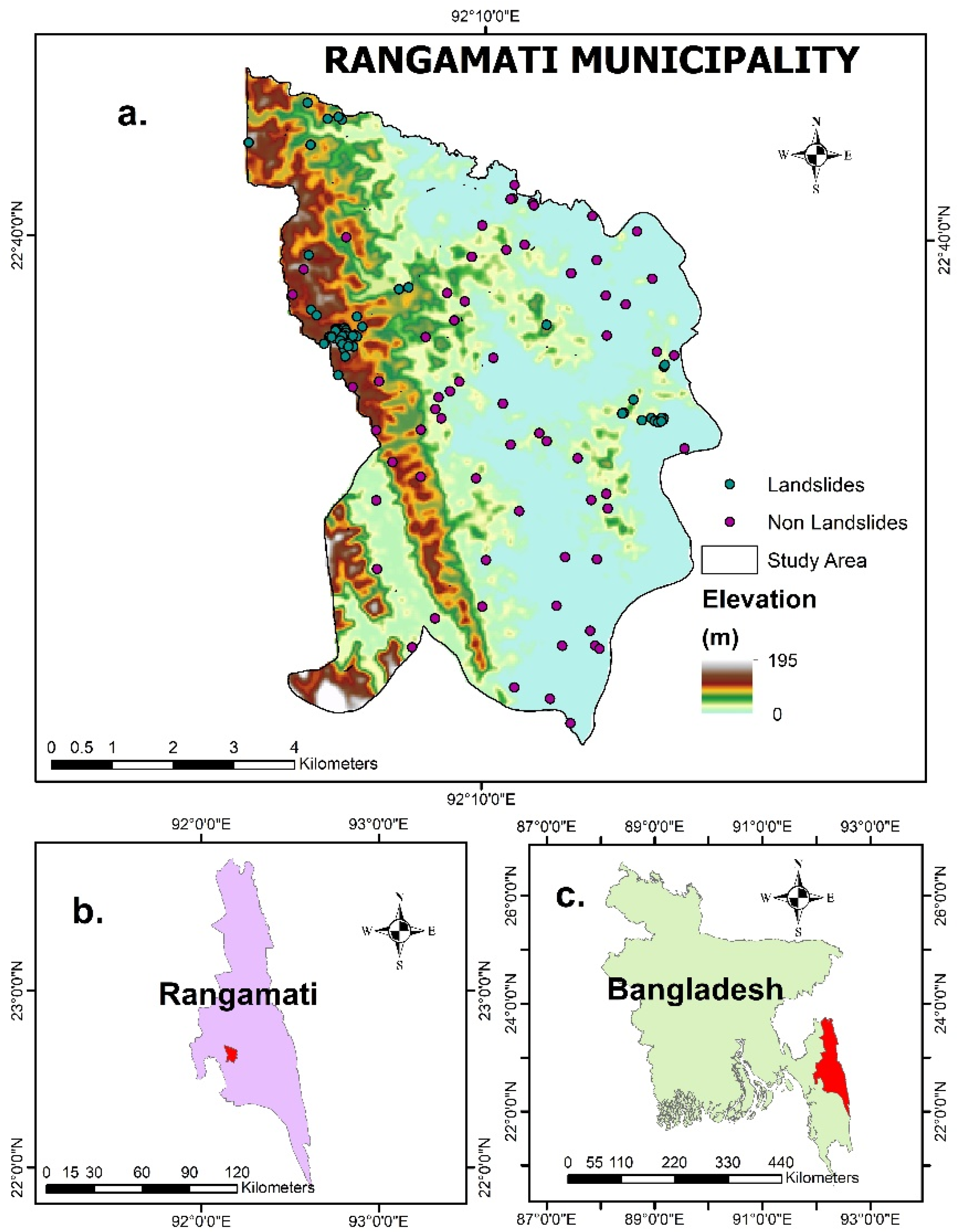
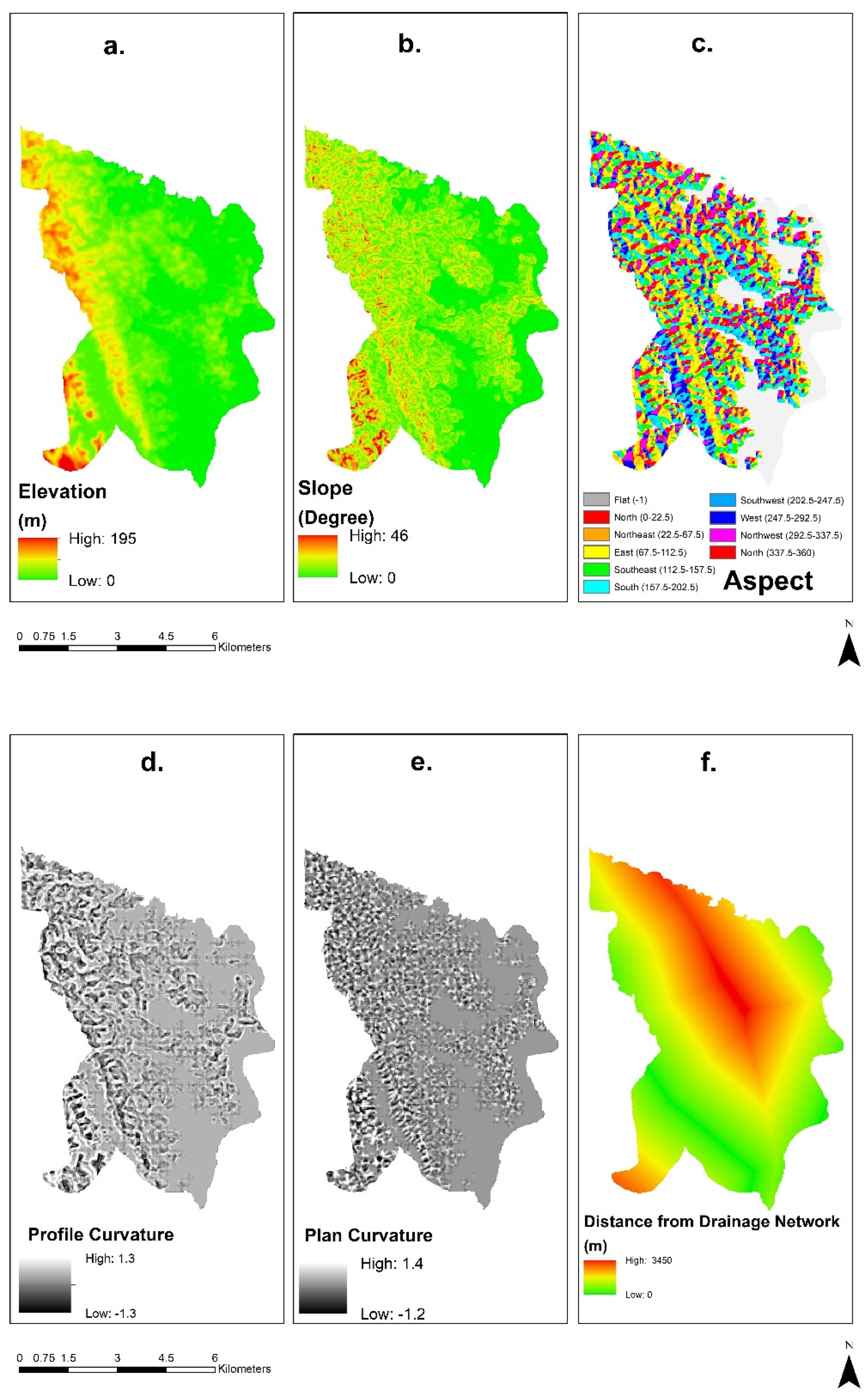
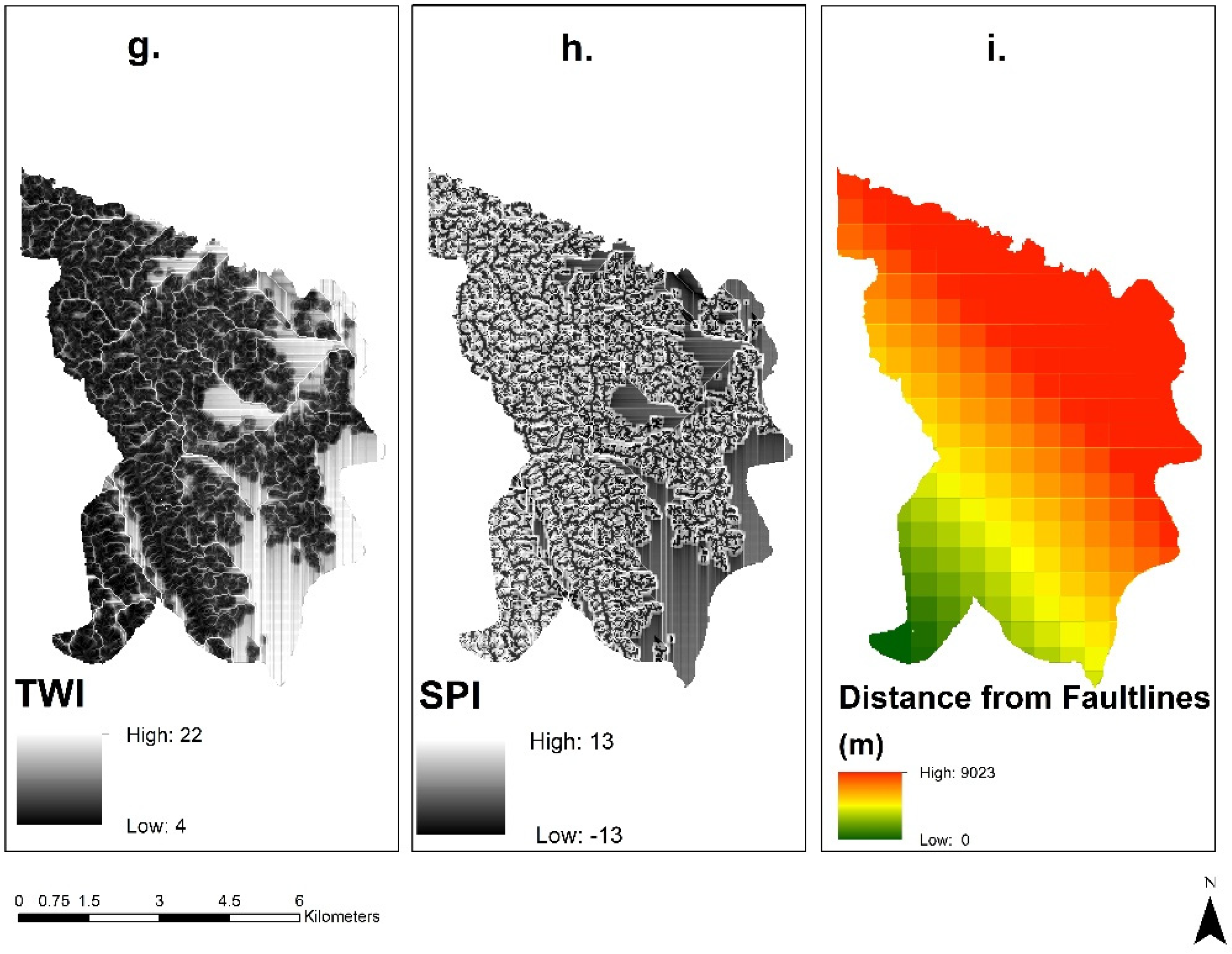
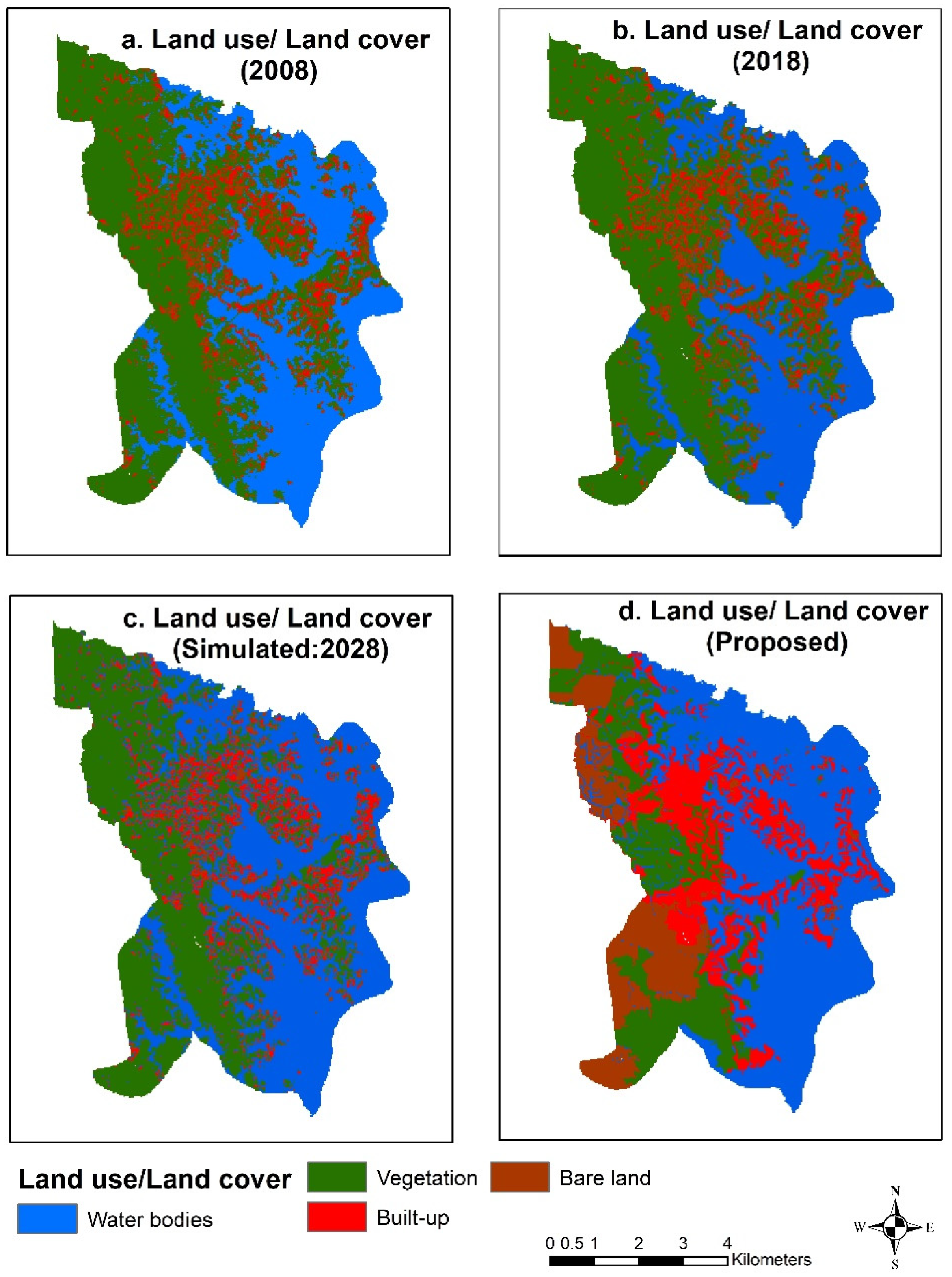
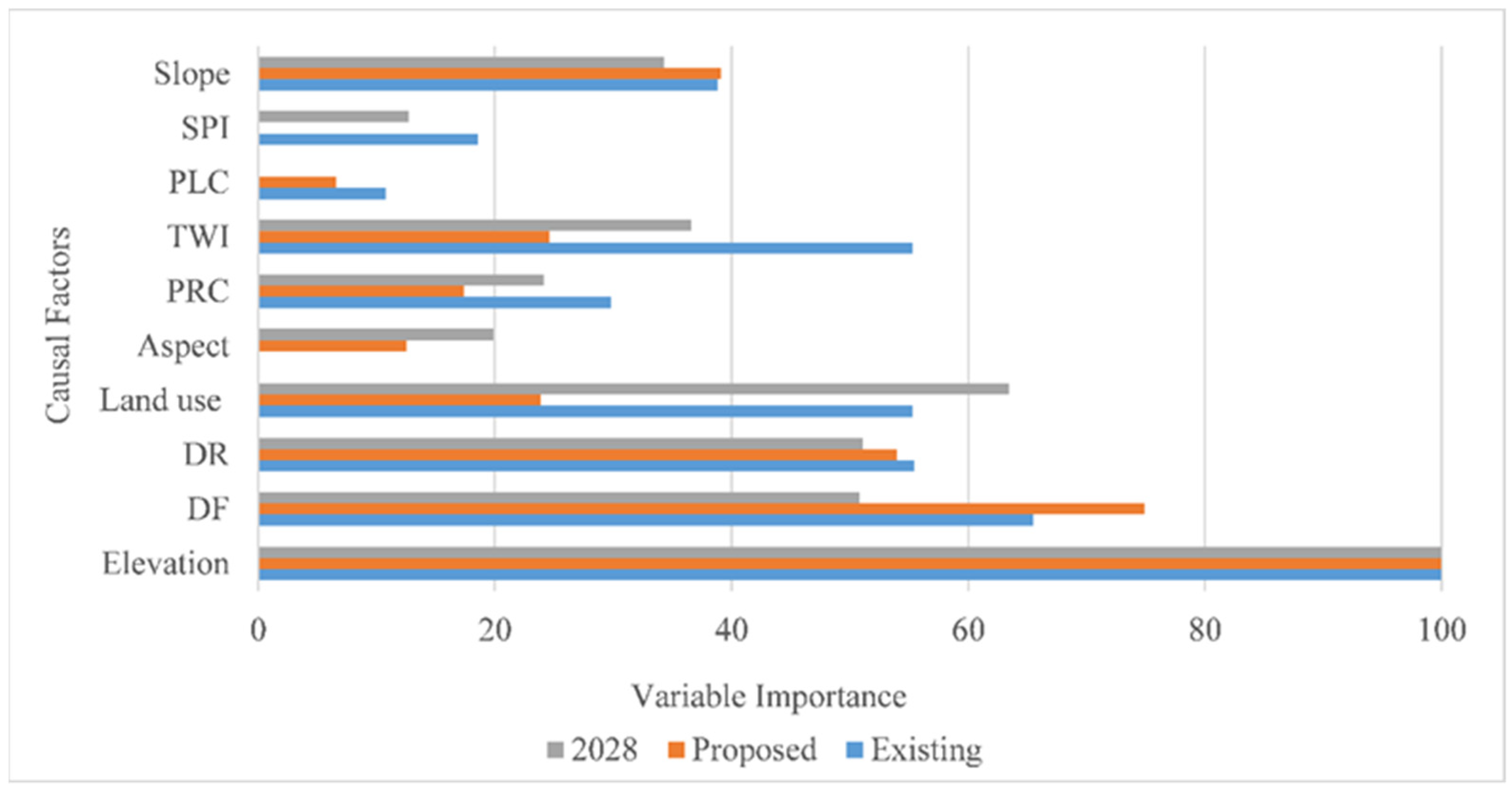

| Factor Type | Influencing Factor | Data Source |
|---|---|---|
| Socioeconomic Factors | Population Density | LandScan Project |
| Proximity to Building Infrastructure | Distance from the Road Network | GeoDash |
| Distance from Urban Areas | Landsat 8 | |
| Climatic Variables | Rainfall | Bangladesh Meteorological Department (BMD) |
| Elevation | ASTER (30 m) | |
| Slope | ASTER (30 m) | |
| NDVI | Abedin et al., 2020 | |
| Distance from Drainage Network | GeoDash |
| LULC Types | Waterbodies | Vegetation | Bare Land | Built-Up |
|---|---|---|---|---|
| Waterbodies | 0.90 | 0.09 | 0.0 | 0.0 |
| Vegetation | 0.04 | 0.36 | 0.28 | 0.34 |
| Bare land | 0.0 | 0.01 | 0.93 | 0.06 |
| Built up | 0.0 | 0.08 | 0.04 | 0.88 |
| Scenario | Year | Waterbodies (%) | Vegetation (%) | Built-Up (%) | Bare Land (%) |
|---|---|---|---|---|---|
| 2008 | 50.2 | 40.2 | 4.3 | 5.1 | |
| Base Year | 2018 | 48.9 | 36.5 | 8.2 | 6.5 |
| Business as Usual (BAU) | 2028 | 40.8 | 30.7 | 14.5 | 10.6 |
| Proposed | 46.7 | 19.2 | 14.9 | 19.2 |
| Model | Land Use | Susceptibility | Area (%) | Increase (+) or Decrease (−) (Based on Existing Susceptibility) (%) |
|---|---|---|---|---|
| Random Forest | Existing | Low | 63.6 | - |
| Moderate | 16.2 | - | ||
| High | 20.2 | - | ||
| Proposed | Low | 59.0 | −7.2 | |
| Moderate | 15.0 | −8.0 | ||
| High | 26.0 | +28.7 | ||
| 2028 (Simulated) | Low | 53.0 | −16.7 | |
| Moderate | 19.9 | +22.8 | ||
| High | 27.1 | +34.2 |
| Susceptibility Class | Land Use | Vegetation (%) | Waterbodies (%) | Bare Land (%) | Built-Up (%) |
|---|---|---|---|---|---|
| Low | Existing | 58.2 | 95.8 | 37.9 | 53.8 |
| Moderate | 22.4 | 4.2 | 28.9 | 23.8 | |
| High | 19.4 | 0.0 | 33.2 | 22.4 | |
| Proposed | Vegetation (%) | Waterbodies (%) | Bare land (%) | Built-up (%) | |
| Low | 37.3 | 78.4 | 12.2 | 38.3 | |
| Moderate | 22.2 | 13.0 | 20.0 | 34.6 | |
| High | 40.5 | 8.6 | 67.8 | 27.1 | |
| Simulated | Vegetation (%) | Waterbodies (%) | Bare land (%) | Built-up (%) | |
| Low | 22.1 | 69.0 | 7.6 | 11.2 | |
| Moderate | 43.5 | 31.0 | 27.0 | 46.4 | |
| High | 34.4 | 0.0 | 65.4 | 42.4 |
| Model | Land Use Data | Success Rate | Prediction Rate |
|---|---|---|---|
| Random Forest | Existing | 88.9 | 82.7 |
| Proposed | - | 81.4 | |
| 2028 | - | 78.3 |
Publisher’s Note: MDPI stays neutral with regard to jurisdictional claims in published maps and institutional affiliations. |
© 2022 by the authors. Licensee MDPI, Basel, Switzerland. This article is an open access article distributed under the terms and conditions of the Creative Commons Attribution (CC BY) license (https://creativecommons.org/licenses/by/4.0/).
Share and Cite
Rabby, Y.W.; Li, Y.; Abedin, J.; Sabrina, S. Impact of Land Use/Land Cover Change on Landslide Susceptibility in Rangamati Municipality of Rangamati District, Bangladesh. ISPRS Int. J. Geo-Inf. 2022, 11, 89. https://doi.org/10.3390/ijgi11020089
Rabby YW, Li Y, Abedin J, Sabrina S. Impact of Land Use/Land Cover Change on Landslide Susceptibility in Rangamati Municipality of Rangamati District, Bangladesh. ISPRS International Journal of Geo-Information. 2022; 11(2):89. https://doi.org/10.3390/ijgi11020089
Chicago/Turabian StyleRabby, Yasin Wahid, Yingkui Li, Joynal Abedin, and Sabiha Sabrina. 2022. "Impact of Land Use/Land Cover Change on Landslide Susceptibility in Rangamati Municipality of Rangamati District, Bangladesh" ISPRS International Journal of Geo-Information 11, no. 2: 89. https://doi.org/10.3390/ijgi11020089
APA StyleRabby, Y. W., Li, Y., Abedin, J., & Sabrina, S. (2022). Impact of Land Use/Land Cover Change on Landslide Susceptibility in Rangamati Municipality of Rangamati District, Bangladesh. ISPRS International Journal of Geo-Information, 11(2), 89. https://doi.org/10.3390/ijgi11020089







